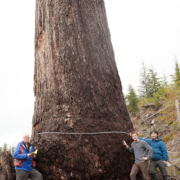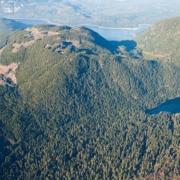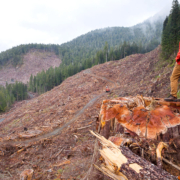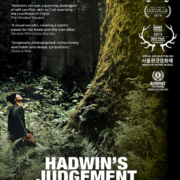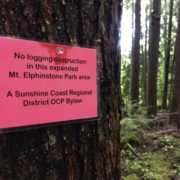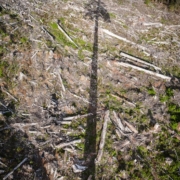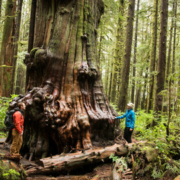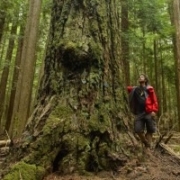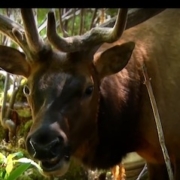Archive for month: September, 2016
ACTION ALERT: Please Write your Mayor & Council to Support a Natural Lands Acquisition Fund ("Resolution B128"), going up for vote this week at the Union of BC Municipalities (UBCM) AGM Sept.26 to 30!
/in Take Action/by TJ WattThe Union of BC Municipalities (UBCM) will be voting at their AGM this week on a motion asking the BC government to implement an annual provincial fund to purchase and protect endangered natural spaces on private lands using the accumulated unredeemed beverage container deposits, estimated to be worth $10 to $15 million/ year in BC (see Resolution B128, sponsored by Highlands). Earlier this year the Association of Vancouver Island and Coastal Communities (AVICC), representing 53 local governments, passed the resolution, and now it’s time to snowball the support from municipalities across BC to pressure the provincial government!
Please WRITE an EMAIL to your mayor and council to express your support for this motion.
Ask them to:
- Support Resolution B128 sponsored by Highlands, and supported by the Association of Vancouver Island and Coastal Communities (AVICC), calling on the province to establish an annual fund to purchase and protect endangered ecosystems on private lands using the accumulated funds from unredeemed beverage container deposits (ie. “Pop for Parks” fund), worth an estimated $10 million/year or more.
- Note that many of the most endangered ecosystems in British Columbia, as well as many community drinking watersheds and areas of high recreational and scenic importance, are found on private lands that are threatened with development.
- Please follow the good example of the Capital Regional District’s $3.7 million/year Land Acquisition Fund, which has raised over $35 million since the year 2000 to purchase over 4500 hectares of private lands to add to the regional parks system, including such beloved places as Jordan River, the Sooke Hills and Potholes, Burgoyne Bay and Mount Maxwell on Saltspring Island, and lands between Thetis Lake and Mount Work parks. A larger provincial equivalent would be a major boost to conservation efforts in BC.
- Note also that unredeemed bottle deposits are used in many jurisdictions to fund land conservation, including New York State, Massachussets, Michigan, Maine, and Connecticut.
- See the report “Finding the Money to Buy and Protect Natural Lands”, by the University of Victoria’s Environmental Law Centre, which details over a dozen mechanisms used in jurisdictions across North America to raise funds for protecting land, including the “Pop for Parks” mechanism.
*** Be sure to include your full name and address so that they know you are a real person.
More Details:
Momentum is growing as over 20 major BC conservation and recreational groups, several city councils, as well as the Association of Vancouver Island and Coastal Communities (AVICC) have supported the call for the BC government to establish a dedicated provincial fund that can be used to purchase and protect endangered private lands of high environmental and recreational significance.
The University of Victoria’s Environmental Law Centre has prepared a report for the Ancient Forest Alliance outlining some potential mechanisms to support such a fund, including the proceeds from unredeemed beverage container deposits, resource taxes on fossil fuels, property transfer taxes, income tax check-offs, etc.
About 5% of British Columbia’s land base is private, where new protected areas require the outright purchase of private lands from willing sellers, while 95% is Crown (public) lands where new protected areas are established by government legislation. However, a high percentage of BC’s most endangered and biologically diverse and rich ecosystems are found on private lands – which tend to be found in temperate lower elevations and major valleys where most humans live. As a result, private lands are disproportionately important for conservation efforts. In particular, southeastern Vancouver Island, the Gulf Islands, the Lower Mainland, the Sunshine Coast, and the Okanogan Valley contain much of the private lands in BC, the greatest concentrations of endangered species, and the most heavily visited natural areas, and would benefit the most from such a fund.
The provincial fund would be similar to the Capital Regional District’s existing Land Acquisition Fund that has helped to protect thousands of hectares of beloved green spaces around Victoria including the Sooke Hills, Sooke Potholes, Jordan River, and Mount Maxwell on Saltspring Island.
Read our MEDIA RELEASE from earlier this year at: https://16.52.162.165/news-item.php?ID=963
See an article in the Times Colonist at: https://www.timescolonist.com/news/local/push-for-provincial-land-acquisition-fund-gathers-steam-1.2156674 and in Island Tides at: https://islandtides.com/assets/reprint/environment_20160128.pdf and the original article in the Times Colonist at: https://www.timescolonist.com/news/local/jack-knox-pop-bottles-could-give-green-funding-extra-fizz-1.2131156
Read the report by the UVic Environmental Law Centre (ELC), ‘Finding the Money to Buy and Protect Natural Lands’: https://www.elc.uvic.ca/wordpress/wp-content/uploads/2015/12/FindingMoneyForParks-2015-02-08-web.pdf
Old-Growth Clearcutting Fragments “Big Lonely Doug’s Mountain” as Calls for Protection Expand during National Forest Week and before UBCM Annual General Meeting
/in Media Release/by TJ WattVICTORIA: Hadwin’s Judgement – Film Screening Fundraiser for the Ancient Forest Alliance! Sept. 29
/in Announcements/by TJ Watt- John Vaillant, award-winning author of The Golden Spruce
- Elizabeth Yake, producer of Hadwin’s Judgement
- Ken Wu and TJ Watt, founders of the Ancient Forest Alliance
ABOUT THE FILM – HADWIN’S JUDGEMENT
Editorial: Victoria must intervene in renewed ‘war in the woods’
/in News Coverage/by TJ Watt
This is a big deal: The Vancouver Sun editorial board is calling on the BC Liberal government to show some actual leadership and chart a new course of policies regarding the fate of our old-growth forests as conflicts escalate in places like the Sunshine Coast and Vancouver Island! While we don't agree with all of the sentiments they've expressed, the main fact that BC's largest newspaper recognizes that the status quo of old-growth liquidation is ramping up conflict and uncertainty in the forest industry and requires government leadership in the lead-up to a provincial election next May puts big pressure on the BC Liberal government to change course.
They write:
“There is a legitimate discussion to be had about the value of old-growth forests, about whether what remains on the South Coast and Vancouver Island is sufficiently protected, about the extent to which the remaining inventory should be protected, and about resource jobs and the rights of companies to do legal business. Surely, however, there is also a clear role for the provincial government, which has duties of both environmental stewardship and resource management, to serve as an intermediary in such conflicts by providing clear, science-based, arm’s-length evidence as the foundation for an even-handed conversation and to help the two groups whose interests it represents to find common ground. More leadership and less lethargy from Victoria, please.”
*******
The Conference Board of Canada warns that global economic growth is weakening, exacerbated by the uncertainties of the United Kingdom’s decision to quit the European Union and the coming presidential election in the United States and what its outcome might mean for trade agreements — softwood lumber, for example — both of which have the potential to undermine Canada’s own relatively fragile economic recovery.
B.C.’s economy may be the strongest in the country right now, but the last thing it needs is to revisit the rancorous “War in the Woods” that convulsed the political landscape in the 1990s. Environmental activists spiked trees, damaged equipment, blockaded roads, sparked international boycotts, and were carted off to mass civil disobedience trials in numbers never before seen in Canada. Their opponents heaved rocks, waved nooses, adorned themselves with venomous T-shirts advocating that young female environmental protesters would benefit from being sexually assaulted, and on one occasion put on masks and rampaged through a camp at night menacing young people.
So, recent events on the Sunshine Coast where protesters erected a flaming barricade to block access to a site above Roberts Creek at which a forest company is cutting old-growth timber adjacent to Mount Elphinstone Provincial Park are disturbing.
Environmentalists argue that the park isn’t big enough and fragments the old-growth forest — some stands are 500 to 600 years old — into three ecological islands which total only about 140 hectares. They want the contested site blue-listed as a vulnerable ecosystem and they propose a 1,500-hectare expansion to create a contiguous park.
The forestry company, frustrated with protesters, has obtained a temporary injunction to prevent interference with legal logging activity after winning a B.C. Timber Sales auction giving it access to 18 hectares in the disputed area. It will leave the oldest Douglas firs standing. But protesters object that the injunction, obtained before a judge in Vernon, was a sneaky, underhanded tactic intended to deny them an opportunity to make a submission.
Some protesters vow to defy the injunction. Clearly, the forest company plans to defy the protests.
Can we all take a deep breath, please, step back from this escalating conflict and try to work out an agreement? Lighting fires in the midst of an old-growth forest seems an odd way to go about arguing for its protection. Using the courts and police as a proxy for governance by elected officials is an old and controversial tactic that perhaps should be re-thought.
There is a legitimate discussion to be had about the value of old-growth forests, about whether what remains on the South Coast and Vancouver Island is sufficiently protected, about the extent to which the remaining inventory should be protected, and about resource jobs and the rights of companies to do legal business. Surely, however, there is also a clear role for the provincial government, which has duties of both environmental stewardship and resource management, to serve as an intermediary in such conflicts by providing clear, science-based, arm’s-length evidence as the foundation for an even-handed conversation and to help the two groups whose interests it represents to find common ground. More leadership and less lethargy from Victoria, please.
Action Alert: Speak up for Ancient Forests to the Union of BC Municipalities (UBCM)!
/in Take Action/by TJ Watt- The UBCM should introduce the resolution calling on the province to protect Vancouver Island’s old-growth forests, which has already been passed by the Association of Vancouver Island and Coastal Communities (AVICC).
- Vancouver Island’s old-growth forests are not just a regional issue, but are of provincial significance. They are globally renowned for their beauty and grandeur, and generate vast amounts of revenues into the provincial economy as tourists from around the world come to visit them. After the US redwoods they are the grandest forests on Earth!
- Old-growth forests are important for supporting endangered species, tourism, recreation, climate stability, clean water, wild salmon, and many First Nations cultures. They are a non-renewable resource under BC’s system of forestry, where second-growth stands are slated for logging every 50 to 80 years, never to become old-growth again.
- The old 1994 Vancouver Island Land Use Plan needs to be updated, as it only protected about 6% of Vancouver Island’s productive old-growth forests in parks, it did not factor in climate change, and unlike the Great Bear Rainforest agreement, it did not include any significant ecological science nor First Nations input. Existing protection levels are inadequate to sustain species at risk and many other values.
- Of 2 million hectares of productive old-growth forests originally on Vancouver Island, only about 500,000 hectares remain. The BC government’s old-growth statistics are highly misleading, intended to make it seem like a large fraction of old-growth forests still remain and are protected. They include vast tracts of low productivity bog and subalpine forests with stunted trees of little commercial value in their old-growth stats, while they exclude 800,000 hectares of largely-logged private forest lands from the original extent of old-growth forests. Muc of these private lands were managed by the BC government with the same regulations as Crown lands, until they were deregulated in recent years.
Feature: Big Lonely Doug
/in News Coverage/by TJ WattCheck it out! The Walrus Magazine has a feature about Big Lonely Doug, Canada's 2nd largest Douglas-fir tree, the forestry worker Dennis Cronin who decided to leave him standing, and the battle for old-growth forests on Vancouver Island! Photos by the Ancient Forest Alliance's TJ Watt!
*******
On a sunny morning in the winter of 2011, Dennis Cronin parked his truck by the side of a dirt logging road, laced up his spike-soled cork boots, put on his red cargo vest and orange hard hat, and stepped into the trees. He had a job to do: walk one of the few remaining stands of old-growth forest on Vancouver Island and flag it for clear-cutting. Known as cutblock number 7190, the twelve hectares fringing the north bank of the Gordon River near Port Renfrew, British Columbia, held some of the largest and oldest trees in the country.
Cronin began his survey at the low side of the cutblock. Every twenty-five metres, he reached into his vest pocket for a roll of neon-orange plastic ribbon and tore off a strip. The colour had to be bright to catch the eye of the fallers who would follow. He tied the inch-wide sashes around small trees or low-hanging branches. “Falling Boundary” was printed on each ribbon.
Then he surveyed the pitches and gradients of the land to plot where a road could be ploughed that would allow for the easiest extraction of logs. Walking in a straight line, he tore strips off another roll of ribbon, this one hot pink and marked with the words “Road Location.” Any creek he came across, he flagged in red. When he was done, the green-and-brown grove was lit up with flashes of colour.
As he waded through the thigh-high undergrowth, something caught his attention: a Douglas fir, poking up through the forest’s canopy and with a trunk wider than his truck. It was one of the tallest trees he had ever come across in his four decades in the logging industry—nearly the height of a twenty-storey building.
He didn’t know it then, but Cronin was standing under the second-largest Douglas fir in the country—later confirmed to be sixty-six metres tall, nearly four metres wide, and almost twelve metres in circumference. The tree’s deeply crevassed trunk was limbless until well above the forest canopy, and its grain looked straight, too: a wonderful specimen of timber. Encased within the foot-thick corky bark was enough wood to fill four logging trucks or to frame five 2,000-square-foot houses. As it could also be turned into higher-priced beams and posts for houses in Victoria and Vancouver, or shipped across the Pacific Ocean to Japan, this single tree would fetch tens of thousands of dollars.
Various large trees dominate these rainforests—western red cedars, Sitka spruces, western hemlocks—but the Douglas fir is the real icon of BC. It was prized by the settlers who built along the coast throughout the nineteenth century. In his 1918 book, Steep Trails, Scottish-American naturalist John Muir praised the species as “tough and durable and admirably adapted in every way for shipbuilding, piles, and heavy timbers.” Loggers and millers found the wood dimensionally stable—it doesn’t twist or warp when drying—while consumers prized its pronounced grain and warm colour, which made it ideal for flooring, doors, windows, and beams. Today, the species produces more timber than any other tree in North America.
Cronin reached into his vest pocket for a ribbon he rarely used, tore off a strip, and tied it to a thin root protruding from the base of the trunk. The tape wasn’t pink or orange but green, and along its length were the words “Leave Tree.”
Within a year, cutblock 7190 would be gone. Every wiry cedar, every droopy-topped hemlock, every great fir cut down and hauled away—all except one. Today, Cronin’s towering fir is one of the last of a threatened species in coastal BC, where 99 percent of the old-growth Douglas firs have been logged.
Less than a year after retiring, Cronin died of cancer, on April 12, 2016, in his home in Lake Cowichan, an hour’s drive from cutblock 7190. His career was dedicated to levelling forests, and yet by saving this one tree, he created a symbol that is doing more to raise awareness about the cutting of old growth on Vancouver Island than any protest, march, or barricade.
The words “old growth” suggest a Tolkienesque grove where every tree is a behemoth. But in reality, each stage of life is represented, from seedling to skyscraper. These forests are not simply original; they are complete.
The patches of old-growth Pacific temperate rainforest on Vancouver Island were once part of a thick band that fringed the continent from Alaska to northern California. Under the dark-green foliage, thick salal bushes make one section impenetrable to pedestrians; another opens into a clearing. Some trees appear painted in lime-green moss, while others drip with grey lichen. The larger trees pierce the canopy, allowing long beams of light to penetrate.
On the ground, a blown-down cedar can lie nearly intact for a century, slowly decomposing and becoming a “nurse log” in which opportunistic seedlings can take root. Any tree that falls, anything that dies, remains. Every hectare contains more biomass—the total volume of live and decaying flora and fauna—than any other ecosystem on the planet, greater even than the tropics, where the heat breaks down dead matter more quickly. Life teems in every square metre: insects, fungi, birds. One researcher has shown that 18,000 invertebrates can be found under a single pair of boot prints. Not only are these forests more efficient at absorbing carbon from the atmosphere than smaller second-growth trees, they also present one of the few environments in the world where large carnivores (wolves, mountain lions, and bears) and ungulates (deer and elk) exist alongside some of the biggest trees. The Douglas firs in particular play a key role, transferring nutrients from their great heights to smaller saplings below through mycorrhizal fungi that link together the roots of various species in an underground network.
It’s here, around the soggy and wind-beaten town of Port Renfrew, two hours up the coast from Victoria, that trees grow especially big. In one of the wettest places in Canada, where rain falls two out of every three days, they thrive in the flat, wet valley bottoms.
It was because of these forests that Cronin got a job as a logger forty-two years ago: he wanted to work outdoors, in nature, with sap on his hands and mud on his jeans. For more than two decades, during the heyday of modern logging, he walked the forests as a hook tender, leading a crew that hauled logs. “It was continuous clear-cut back then. You just cut everything down,” Cronin told me, shortly before he died. The introduction of mechanized feller-bunchers—capable of chopping, de-limbing, and cutting trees to length—made it possible for loggers to clear a hectare of second-growth forest in a matter of hours. But few machines are capable of felling old growth; the trees are too big. Every great tree that is cut down on Vancouver Island is done by hand. While it could take 500 years for a fir to reach fifty metres tall and two metres wide, it can take a skilled faller with a chainsaw five minutes to bring it down.
In the early 1990s, Cronin began noticing a shift in attitudes toward logging. “Everybody was trying to get dirt on you all the time,” he said. “They had cameras on you.” Two of the most successful anti-logging campaigns in Canadian history were waged over these forests. Protestors chained themselves to the base of giant Sitka spruces and camped out in the treetops in the Carmanah Valley, just north of Port Renfrew. In 1990, the province paid the largest timber company in the region, MacMillan Bloedel, $83.75 million for lost tree-farm licences and established Carmanah Walbran Provincial Park.
Three years later, farther up the coast near Tofino, the protests over proposed logging around Clayoquot Sound became known as the War in the Woods. The standoff between environmentalists and timber workers reached fever pitch when activists spent the summer blockading roads to stop fallers from reaching their cutblocks. In response, members of the logging community dumped 200 litres of excrement near the activists’ staging site. In the end, 800 protesters were arrested and convicted of defying an injunction—the largest act of civil disobedience in the country’s history. In 1995, Clayoquot Sound was protected by provincial order, and in 2000, it was designated a UNESCO Biosphere Reserve. A year later, the Forest Practices Code of British Columbia Act (now the Forest and Range Practices Act) became law, establishing new regulations for logging companies, reforestation policies, road construction, and the treatment of wildlife habitats and watersheds.
It was during this time that Cronin became an industry engineer, a job that required him to enter intact forests and map them for logging. He was often the first one on the scene. In this role, he began seeing trees differently. “Fallers see them lying on the ground, not standing up,” he said. As big timber continued to vanish, he watched as the unbroken evergreen that once covered Vancouver Island was reduced to rare and isolated groves.
Two decades later, the battle continues. The provincial government still approves logging leases on patches of old growth in unprotected areas. And timber is still big business in BC, where one in sixteen jobs is related to the forest industry, which annually contributes $12 billion to the provincial GDP.
But while cutting down old-growth forest may be profitable in the short term, there also is an economic argument to be made for keeping these trees standing. Only 10 percent of the original forests that hold the giants remain on Vancouver Island. Given the value of old-growth as a draw for eco-tourists, long-term economic output might well be maximized if the logging industry were to focus on second-growth forest, which covers much of the island. While second-growth yields less timber per hectare, the trees are planted in a way that allows them to be harvested quickly and easily. “With second growth, there’s no waste. What you see is what you’ll get,” Cronin said.
Cutting old growth, in other words, represents a complete lack of foresight. We are on the cusp of losing the last remaining giant trees of Vancouver Island, and it won’t take a few years or a decade but many centuries to get this resource back.
For a year, Cronin’s tree swayed quietly on its own. But in early 2012, TJ Watt—who was photographing old-growth and clear-cut areas for the Ancient Forest Alliance (AFA), a Victoria-based non-profit—stumbled upon it while driving on logging roads thirty minutes north of Port Renfrew.
It was a tree unlike any Watt had photographed before. In the middle of the clear-cut, the fir stood like an obelisk in a desert. He estimated it must have been approximately 1,000 years old; it would have been a seedling around the time the Norse explorer Leif Ericson was building sod houses in what is now Newfoundland.
Two years later, after climbing the tree to measure its height, the AFA issued a press release on March 21—the International Day of Forests—titled “Canada’s Most Significant Big Tree Discovered in Decades!” The statement noted that the trunk bore a deep scar (likely the result of loggers having used it as an anchor for cables while hauling logs out of the cutblock) and that the tree’s largest branch lay on the ground nearby. The AFA suggested it had been ripped off by a storm because the tree had lost its buffer from the wind when the forest around it had been cut. The claim frustrated Cronin, who told me he’d seen the branch resting in the undergrowth the day he flagged the fir.
This single tree provided exactly what the AFA needed: an image that could symbolize its cause. Heroic life persevering amid destruction. The organization christened him Big Lonely Doug, and the tree instantly became a celebrity. Its story rippled through the media—the Globe and Mail called it “the loneliest tree in Canada.” Numerous environmental advocacy groups used the photographs, as did the Victoria clothing company Sitka, which, as the crowds visiting the tree grew, began diverting proceeds to construct a trail and viewing platform “to keep him company.” Much of the online chatter centred on how Big Lonely Doug would be blown over by the wind. But the tree had already endured stronger weather. When Cronin walked the forest in 2011, he noticed that most of the surrounding trees were 150-year-old hemlocks that had grown back after a hurricane-force gale had torn through the valley and knocked down all trees but the greats. “He’s used to the wind,” Cronin said, “so he’s got a chance.” It’s not the first time Big Lonely Doug has stood alone.
Now tourists are visiting Port Renfrew not only to hike the famous West Coast Trail, but to head inland and stand under some of the largest trees in the world. Once a town where virtually all of the 200 residents were connected to the logging industry, Port Renfrew is rebranding itself as “Canada’s Tall Tree Capital.” In December, the town’s chamber of commerce called for a moratorium on logging old growth in the region, citing the business and tourism potential of keeping the big trees standing. The town’s tourist brochure includes a map to the area’s large trees, including Big Lonely Doug, and features a picture of the great tree on the back cover.
In late May, the BC Chamber of Commerce, which represents 36,000 businesses, passed a resolution calling on the provincial government to increase old-growth protection, stating, “the local economies stand to receive a greater net economic benefit over the foreseeable future by keeping their nearby old-growth forests standing.” They cited Big Lonely Doug as an example. Thanks to the popularity of the big trees near Port Renfrew, local hotels and B&Bs have reported a surge in demand of between 75 and 100 percent each year since 2012.
Local support, however, isn’t enough. It took years of campaigning from the AFA to establish a forty-hectare Old Growth Management Area, nicknamed Avatar Grove, in February 2012. The AFA has since constructed boardwalks through the forest to ease the impact of the thousands of visitors who are flocking to the area. But during the time the AFA worked to protect Avatar Grove, cutblock 7190 down the road was clear-cut, along with dozens of others in the Gordon River valley. “It’s so difficult to fight spot by spot,” Watt says. “In the time it takes to fight for five or six stands, you might lose hundreds.”
Hundreds more groves—such as the one adjacent to Big Lonely Doug and cutblock 7190 that contains dozens of three-metre-wide cedars and firs—remain flagged and ready to be razed, tucked away down kilometres of obscure logging roads across Vancouver Island, far from where the pavement ends. “Often the first and last people who are seeing these forests are the people who are cutting them down,” says Watt.
Throughout his career, Cronin made other discoveries while working in the forests of Vancouver Island. He once found a ten-metre-long canoe two and a half kilometres from the ocean that had been partially dug out of a felled cedar. It had been abandoned more than a century ago, he estimated, judging by the eight-inch-wide tree growing out of the log. He uncovered pre-European-contact stone tools and stacks of cedar shakes intended for longhouses. And in May 2014, while surveying a patch of forest on a mountainside near Port Renfrew, he stumbled upon the wreckage of a Second World War–era Avro Anson bomber that had mysteriously vanished while on a navigational training flight on October 30, 1942.
But of all Cronin’s discoveries, the big fir in cutblock 7190 may turn out to be his biggest legacy. During that sunny day in the winter of 2011, he unintentionally created a monument that is drawing pilgrims away from the famed coastlines and over to the front lines of the logging at the heart of Vancouver Island. “Back in the day, that tree would’ve been cut down,” Cronin said. “I’m glad it grabbed everybody’s attention. Nobody would have ever seen it if we hadn’t logged that piece.” An hour east of Port Renfrew grows the Red Creek Fir, the world’s largest Douglas fir. Nearby is the San Juan Spruce, Canada’s largest Sitka spruce. The Carmanah Giant, Canada’s tallest tree, is located two kilometres off the West Coast Trail. But these and other great trees in the area stand within intact forests and so don’t create the stark contrast that sets Big Lonely Doug apart.
Before he died, Cronin often returned to stand under the great tree he saved. He would bring his wife, Lorraine, and friends to proudly show them. “It’s a legacy, ya know? Even though I’m a logger and I’ve taken out millions of trees,” he said. Like the fir, Cronin was the last of his kind. If the remaining old growth is eventually brought down, the generations of loggers who put axe and chainsaw to trunk will have no more trees to cut, and the shift to mechanized falling will be nearly complete. When that happens, Vancouver Island’s old-growth legacy will have been permanently cut away, and with it, any potential for communities like Port Renfrew to build new economies out of groves left intact and trees left vertical.
For now, Big Lonely Doug stands tall. The tree’s thick roots, as wide as a person, draw groundwater up to its glossy needles. Below, huckleberry bushes and seedlings poke through the sun-bleached scraps where great cedar, spruce, and hemlock once thrived in seemingly inexhaustible quantities.
Each afternoon, the sun sinks toward the patchwork hills and casts a silhouette that nearly reaches the neighbouring stand of old growth—the shadow of a great sundial ticking around the clear-cut. Still tied at the base of the tree, Cronin’s green ribbon flutters in the wind.
Read more: https://thewalrus.ca/big-lonely-doug/
Port Renfrew: Walking among ancient giants
/in News Coverage/by TJ WattCheck it out! New Zealand's largest newspaper has an article about the Ancient Forest Alliance, the importance of old-growth forests for the tourism economy of Port Renfrew, and the campaigns to protect old-growth forests including the Central Walbran Valley.
*****
Visitors to British Columbia, on Canada's Pacific southwest coast, will no doubt be expecting to see some of the thick evergreen forests the area is famous for worldwide. And of course you won't have to go far to see such trees. You will no doubt see plenty as you fly down the coast to Vancouver airport. But the majority of these forests are made up of second-generation trees. The massive giants that can live more than 1000 years are now largely gone from Canada's wooded areas.
On Vancouver Island – a 30-minute flight from downtown Vancouver – 75 per cent of the productive old-growth forests have been logged, including 90 per cent of the valley bottoms, where the biggest trees grow. However, as in New Zealand, small pockets of old growth ancient forest remain, and – like this country – people are rallying to ensure they remain protected from loggers and accessible to visitors keen to view Canada's fascinating botanical heritage.
One such man is T J Watt, who, on a wet spring day, met our small group at an area that has become known as Avatar Grove, a 20-minute drive north of the small coastal settlement of Port Renfrew.
“I came across Avatar Grove in 2009 while looking for old-growth forests and giant trees in the Gordon River Valley near Port Renfrew,” says 31-year-old Watt. “The most accessible old-growth trees usually were logged first, so it's surprising this area still exists, given that it's just a few minutes from the road.”
Watt had to move fast if he wanted to protect the area, which was slated for logging in 2010. He and long-time forest activist Ken Wu had recently formed a group called the Ancient Forest Alliance and, with the Port Renfrew Chamber of Commerce, lobbied for its protection – which was granted in early 2012.
The group has since been constructing a boardwalk to protect the grove's ecological integrity, enhance visitor safety and access, and support the local economy of Port Renfrew and the Pacheedaht First Nation people. The boardwalk and accompanying hikers trail is expected to be completed this year.
Asked whether his project was named before or after the popular 2009 science fiction movie, Watt laughs, and says the area needed a catchier name than just the cutblock number.
“The area is largely untouched and with such amazing old giant trees that were in danger of being cut down, the name Avatar seemed to fit well.”
It is hard to deny that fact, as our group walks among the monumental red cedars, hemlocks, amabilis and douglas firs. The next tree we come across is a gnarled giant that would not be out of place on an alien planet. Its trunk resembles the mottled tubes of a pipe organ and is so tall its upper reaches can barely be seen.
Some of the trees are of such magnificent proportions it is easy see why comparisons are often made with the majestic Californian red woods. One tree, known as the San Juan Spruce, is 62.5m tall with a diameter of 3.7m. The world's largest Douglas fir is also in the area. The red creek fir measures 73.8m high with a 4.2m diameter. Watt has started a company called Big Tree Tours and leads guided hikes to Avatar Grove and the other record-sized trees around Port Renfrew.
“My hope is that the Avatar Grove helps to educate the public about the importance of protecting endangered old-growth forests on other parts of Vancouver Island, like the nearby Walbran Valley and how doing so can not only benefit the environment but the local economy as well,” Watt says.
Asked about the substantial contents of his backpack when the trees are barely 10-15 minutes from the road, Watt says it is mostly emergency gear, food, water and first-aid equipment. “In case anyone gets hurt, you never know. Plus, this a wilderness area. You can still get cougars and bears.”
During our group's hour or so in the grove, no such critters cross our path, but to prove his point Watt says he plans to check a nearby “bear-cam” he set up to see if it has had any large furry visitors.
Also joining our group for the day is Toni Chalk, another young Canadian committed to preserving the local forest areas.
Chalk owns Rainforest Tours, a company that takes guided day-hiking excursions to some of the local sites of scenic beauty. Earlier that day she had taken us to the suitably named Mystic Beach – a beautiful and wild spot that was still shrouded in early morning mist on our arrival. Its remote, unspoilt location attracted US draft dodgers in the 1960s but now it is more popular with hikers and surfers.
The 45-minute walk from the carpark takes us through another heavily wooded area, but this time the trees are all second-generation growth, with little that would be more than 100 years old. Not far from the road she stops to point out three massive tree stumps that would easily be a couple of metres across.
“You can see up there the size of some of the trees that loggers took out of this area”, says Chalk, “but thankfully all this is now part of the Juan de Fuca Provincial Park, so what remains will hopefully be here for some time to come.”
The old-growth forests of Vancouver Island are important for sustaining endangered species, climate stability, tourism and clean water, says Chalk. She says many First Nations tribes use naturally falling old-growth red cedars to build canoes, longhouses and other cultural items.
The largest strand of old-growth trees lies just further north of us in a 500ha section of land known as the Central Walbran Valley.
It is for these areas that Port Renfrew has the reputation as the tall tree capital of Canada.
Later that day our group returns for a tasty dinner at the Renfrew Pub, a stone's throw away from the Wild Renfrew – a small eco-resort featuring 11 well-equipped cottages beside the harbour inlet of Snuggery Cove. The cottages are warm and comfortable – exactly what is needed after a damp day's hiking.
After our meal we talk to one of the Pub's owners, Ian Laing, one of four partners who also own the Wild Renfrew resort, The Coastal Cafe, West Coast Trail Lodge and 180ha of surrounding land.
Laing says Port Renfrew used to be solely the domain of loggers and fishermen, but that is changing.
“The whole area is converting from using up primary resources to eco-tourism,” he says, adding that as well as hiking and surfing, the region has some impressive mountain bike trails and a growing kite-surfing community in the harbour.
Read more: https://m.nzherald.co.nz/travel/news/article.cfm?c_id=7&objectid=11708020
‘Twist and Shout’ Forest Under Threat
/in Announcements/by TJ WattCheck out the website of the Sunshine Coast (Roberts Creek area) based conservation group the Elphinstone Logging Focus who are working to achieve a 2000 hectare expansion to the protected area on Mount Elphinstone. BC Timber Sales has given the go ahead to log the ‘Twist and Shout’ forest within the proposal, which includes numerous veteran old-growth Douglas-firs and redcedars, and local activists have been non-violently protesting there for weeks. See a comprehensive list of updates and coverage and events and how to take action on the “Twist and Shout” section of their website at: https://www.loggingfocus.org/campaigns/protect-the-twist-and-shout-forest/
Also check out some great photos of the forest there by Shel Neufeld: https://www.facebook.com/shel.n.neufeld/posts/10154336717750155?pnref=story
VIDEO: Eden Grove
/in News Coverage/by TJ WattHey friends, check out this great new Shaw TV video about the stunning “Eden Grove” (ie. Lower Edinburgh Grove), one of the finest but endangered lowland valley bottom old-growth forests left on Vancouver Island! Filled with ancient cedars and Douglas-firs, and with bears, cougars, wolves, deer, elk, northern goshawks, and marbled murrelets. Located near Port Renfrew in Pacheedaht territory at risk by Teal-Jones. Thanks to videographer Lorraine Scollan for putting this together!
https://www.youtube.com/watch?v=0kOql0k-EwA
Interesting links
Here are some interesting links for you! Enjoy your stay :)Pages
- ACTION ALERT: Tell the NDP government FRPA amendments must protect old-growth forests
- AFA Policy Recommendations – 2025
- Ancient Forests
- BC Protected Areas Strategy (PAS)
- Before & After Logging – Caycuse Watershed
- Before and After Logging Caycuse 2022
- Biggest Trees
- Bugaboo Ridge Ancient Forest
- Call Premier Horgan to demand funding for old-growth protection in Budget 2022
- Call the BC government
- Cameron Firebreak
- Canada’s Most Impressive Tree – Flores Island
- Cast Your Vote for Ancient Forest Protection!
- Caycuse Logging From Above
- Central Walbran Valley
- Climbing the Largest Spruce in Carmanah
- Conservation Financing
- Contact
- Donate Stocks, Securities, and Mutual Funds
- Echo Lake
- Economic Valuation of Old-Growth Forests on Vancouver Island
- Ecosystem-Based Targets
- Edinburgh Mountain Ancient Forest
- Eldred River Valley
- Exploring & Climbing Ancient Giants
- Fairy Creek Headwaters
- Granite Creek Logging
- Grove of Giant Cedars Clearcut in Quatsino Sound
- Have your say on the BC government’s Old-Growth Strategy
- Hiking Guides
- Home
- Join the Growing Number of BC Businesses Calling for Old-Growth Forest Protection
- Juniper Ridge
- Kanaka Bar Indigenous Protected and Conserved Area
- Kanaka Bar IPCA Proposal
- Katlum Creek
- Katlum Creek
- Klaskish Inlet
- Loup Creek
- Lower Caycuse River
- Mahatta River Logging
- Massive Trees Cut Down
- McKelvie Valley
- McLaughlin Ridge
- Mossy Maple Rainforest
- Mount Horne
- Mt. Freda Ancient Forests
- Nahmint Logging 2024
- Nahmint Valley
- Nahmint Valley
- Old Growth Strategic Review Questionnaire Guide
- Old-Growth 101 – The Facts on Ancient Forests in BC
- Old-Growth Campaigns
- Old-Growth Forest Hikes Near Port Renfrew
- Old-Growth Forest Hikes Near Victoria BC
- Our Mission & Team
- Our Work
- Petition
- Photographer TJ Watt
- Photos & Media
- Policy recommendations to support sustainable, value-added, second-growth forestry jobs in BC
- Pop for Parks Report
- Privacy Policy
- Protect Old-Growth Forests & Endangered Ecosystems in BC
- Provincial Biodiversity and Ecosystem Health Framework
- Provincial Land Acquisition Fund
- Quatsino Old-Growth Under Threat 2023
- Recent News
- Salmon Parks Initiative
- Send a Message
- Send a Message
- Send a Message
- Spruce Bay Old Growth Trail – Port Alice
- Sydney River Valley
- Taylor River Valley
- Thank you for speaking up for ancient forests!
- Thank you for speaking up for BC’s last remaining ancient forests!
- Thank you for speaking up for BC’s last remaining ancient forests!
- Thank you for speaking up for endangered ecosystems!
- Thank You for Speaking Up for Old-Growth Forests!
- Thank you for taking action for ancient forests, your call will begin shortly!
- Thank you for taking action for old-growth
- Thank you for taking action for old-growth
- Vernon Bay
- Videos
- Walbran Headwaters At Risk
- Ways to Take Action
- White River Provincial Park
- Work With Us
- z__Archive Footer – DO NOT EDIT
- z__Footer – DO NOT EDIT
- z__Pre-Footer – DO NOT EDIT
- z__Single Post Footer – DO NOT EDIT
- z__Take Action row – DO NOT EDIT
- z_Send a Message – Call for Ecosystem Based Targets
- Activity Reports
- Ancient Forest / Chun T’oh Whudujut Provincial Park
- Before & After Old-Growth Maps
- 2018 Activity Report & Financials
- History & Successes
- Old-Growth Forests in BC: Frequently Asked Questions
- Parthenon Grove
- 2017 Activity Report & Financials
- Directions to Avatar Grove
- Upper Tsitika Valley
- 2016 Activity Report & Financials
- Avatar Boardwalk
- Building Alliances
- 2015 Activity Report & Financials
- Avatar Grove
- Myths & Facts
- Big Lonely Doug and Clearcut
- Policy Recommendations
- Biggest Stumps
- Port Renfrew Big Trees Map
- Publications
- Cameron Valley Firebreak
- Research & Reports
- Carmanah Research Climb
- Castle Grove
- Cathedral Grove Canyon
- Central Walbran Ancient Forest
- Children’s Forest
- Day Road Forest
- East Creek Rainforest
- Echo Lake
- Eden Grove
- Flores Island
- Hadikin Lake
- Haida Gwaii
- Jurassic Grove
- Klanawa Valley
- Koksilah
- Low Productivity Old-Growth
- McKelvie Valley
- McLaughlin Ridge
- Meares Island
- Mossome Grove
- Mossome Grove Tree Climb
- Mossy Maple Gallery
- Mossy Maple Grove
- Mount Horne
- Mt. Elphinstone Proposed Park Expansion
- Nootka Island
- Roberts Creek Headwaters
- Squirrel Cove Ancient Forest
- Stillwater Bluffs
- Tahsis: Endangered Old-Growth Above Town
- Tree Climb 2014
- Tree Climb 2016
- Walbran Logging
- Walbran Overview
Categories
Archive
- September 2025
- August 2025
- July 2025
- June 2025
- May 2025
- April 2025
- March 2025
- February 2025
- January 2025
- December 2024
- November 2024
- October 2024
- September 2024
- August 2024
- July 2024
- June 2024
- May 2024
- April 2024
- March 2024
- February 2024
- January 2024
- December 2023
- November 2023
- October 2023
- September 2023
- August 2023
- July 2023
- June 2023
- May 2023
- April 2023
- March 2023
- February 2023
- January 2023
- December 2022
- November 2022
- October 2022
- September 2022
- August 2022
- July 2022
- June 2022
- May 2022
- April 2022
- March 2022
- February 2022
- January 2022
- December 2021
- November 2021
- October 2021
- September 2021
- August 2021
- July 2021
- June 2021
- May 2021
- April 2021
- March 2021
- February 2021
- January 2021
- December 2020
- November 2020
- October 2020
- September 2020
- August 2020
- July 2020
- June 2020
- May 2020
- April 2020
- March 2020
- February 2020
- January 2020
- December 2019
- November 2019
- October 2019
- September 2019
- August 2019
- July 2019
- June 2019
- May 2019
- April 2019
- March 2019
- February 2019
- January 2019
- December 2018
- November 2018
- October 2018
- September 2018
- August 2018
- July 2018
- June 2018
- May 2018
- February 2018
- January 2018
- December 2017
- November 2017
- October 2017
- September 2017
- August 2017
- July 2017
- May 2017
- April 2017
- March 2017
- February 2017
- December 2016
- November 2016
- October 2016
- September 2016
- August 2016
- July 2016
- June 2016
- May 2016
- April 2016
- March 2016
- February 2016
- January 2016
- December 2015
- November 2015
- October 2015
- September 2015
- August 2015
- July 2015
- June 2015
- May 2015
- April 2015
- March 2015
- February 2015
- January 2015
- December 2014
- November 2014
- October 2014
- September 2014
- August 2014
- July 2014
- June 2014
- May 2014
- April 2014
- March 2014
- February 2014
- January 2014
- December 2013
- November 2013
- October 2013
- September 2013
- August 2013
- July 2013
- June 2013
- May 2013
- April 2013
- March 2013
- February 2013
- January 2013
- December 2012
- November 2012
- October 2012
- September 2012
- August 2012
- July 2012
- June 2012
- May 2012
- April 2012
- March 2012
- February 2012
- January 2012
- December 2011
- November 2011
- October 2011
- September 2011
- August 2011
- July 2011
- June 2011
- May 2011
- April 2011
- March 2011
- February 2011
- January 2011
- December 2010
- November 2010
- October 2010
- September 2010
- August 2010
- July 2010
- June 2010
- May 2010
- April 2010
- March 2010
- February 2010
- January 2010

